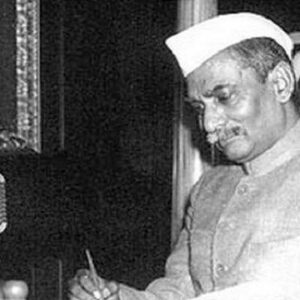Dr Rajendra Prasad was India’s first president. For all Indians, his life has been truly inspirational. Prasad’s interest in Indian politics began in 1911, when he joined the Indian National Congress. Despite initially opposing Gandhi’s principles, he later absorbed the true spirit of Gandhi by adopting him as a mentor, practicing self-discipline, and working tirelessly in the non-cooperation movement. He traveled throughout the country, spreading Mahatma Gnadhi’s ideals and beliefs. He was endowed with extraordinary organizational abilities and leadership qualities and served as the Indian National Congress’s president three times. When India gained independence from British rule, he became a cabinet minister, gradually ascending to the position of President of the Constituent Assembly and later becoming India’s President for two terms. Apart from his political activities, he made a number of literary contributions. His most notable works include ‘India Divided,’ ‘Satyagraha at Champaran,’ ‘Atmakatha,’ and ‘Since Independence.’
Childhood & Adolescence
Rajendra Prasad was born on December 3, 1884, in Zeradei, Bihar, to Mahadev Sahai and Kamleshwari Devi. He was the family’s youngest child.
While his father, a scholar of Persian and Sanskrit, had a formative influence on young Prasad’s life and career, his mother instilled moral values in him through the study of Indian mythology.
He began his education as a deserving student under the tutelage of Moulavi, an accomplished Muslim scholar who taught him Persian, Hindi, and arithmetic.
Later in Patna, he attended Chapra District School and T.K. Ghosh’s Academy. He moved to Calcutta for higher education and was awarded a scholarship to the Presidency College, where he earned a degree in science.
He later switched from science to the arts, earning an MA in Economics in 1907. He first became acquainted with The Dawn Society while in college and became an active member. He was instrumental in the establishment of the Bihari Students Conference in 1906.
After completing his education, he accepted a position as an English professor at the Langat Singh College in Muzaffarpur and was quickly promoted to principal.
In 1908, he resigned from his principal’s chair to pursue a degree in law at Calcutta City College, where he doubled as an Economics professor. In 1915, he earned a master’s degree in law with honors and a gold medal. He earned a doctorate in law from Allahabad University in 1937. Meanwhile, he became a member of the Indian National Congress in 1911.
Career of Rajendra
After completing his legal studies, he began working at the Bihar and Odisha High Court in 1916. He was appointed as one of the first members of the Patna University’s Senate and Syndicate a year later.
He and his volunteers aided Gandhi during his fact-finding mission in Bihar’s Champaran district to ascertain the peasants’ grievances.
As soon as the Indian National Congress passed the Non-Cooperation Movement in 1920, he abandoned his legal career and university responsibilities to enter politics and devote himself entirely to India’s freedom struggle.
He was an active member of the non-cooperation movement, touring states, holding public meetings, raising funds, and inciting people to boycott everything western – from schools and colleges to government offices. He urged people to abandon western clothing in favor of khadi as part of the movement.
Unlike others in the Indian Congress who misjudged Gandhiji’s decision to suspend the civil disobedience movement due to its violent nature, he stood by his mentor. In Bihar, he replicated Gandhi’s Salt Satyagraha, for which he was imprisoned.
In 1934, during the Bombay session, he was elected President of the Indian National Congress. Subhash Chandra Bose resumed the presidency of the INC following Subhash Chandra Bose’s resignation in 1939. His primary objective at the time was to mend the schism in the Indian Congress caused by ideological disagreements between Bose and Gandhi.
In 1942, as a result of Congress’ authorization of the Quit India Movement, a number of Indian leaders were imprisoned, including him. He spent three years in the Bankipur Central Jail before being released on June 15, 1945.
He served as one of the Interim Government’s cabinet ministers following India’s independence from the British Raj, taking charge of the Food and Agriculture Department.
He was elected President of the Constituent Assembly in December 1946, which was established to draft the Indian Constitution.
He was elected India’s first President on January 26, 1950, when the Indian Constitution was adopted. He served in the position for two terms until 1962, making him India’s first and only two-term President.
Throughout his tenure as President of India, he adhered to the Presidential duties and acted independently of politics, as the Constitution requires of the President of India. He was an active participant in state affairs.
Throughout his presidency, he traveled to numerous countries on goodwill missions, including Japan, Ceylon, the USSR, Indo-China, Malaya, and Indonesia. He hoped for peaceful relations with other countries.
In 1962, after twelve years as President of India, he resigned and relocated to Patna, where he stayed on the campus of Bihar Vidyapeeth. He spent the final years of his retirement at Patna’s Sadaqat Ashram.
Awards and Accomplishments
He was conferred with India’s highest civilian award, the Bharat Ratna, for his unwavering contribution as a leader of the Indian National Congress and as President of India.
Personal History and Legacies
At the age of twelve, he married Rajavanshi Devi. Mrityunjaya Prasad was born to the couple.
He died on February 28, 1963, at Patna’s Sadaqat Ashram.
Estimated Net Worth
Rajendra Prasad is one of the wealthiest politicians and is ranked among the most popular. Rajendra Prasad’s net worth is estimated to be around $7Million based on our analysis of Wikipedia, Forbes, and Business Insider.
Trivia
He was the first President of independent India and the only one to serve two terms in the office of President.


